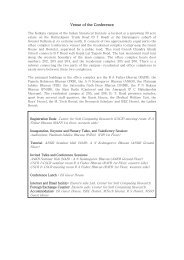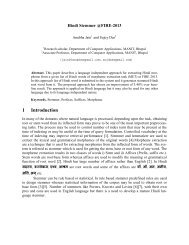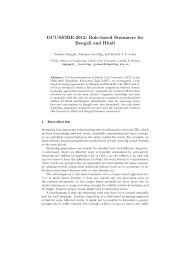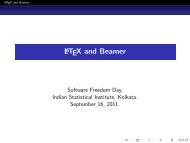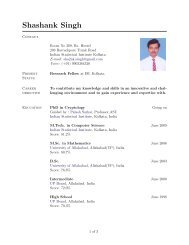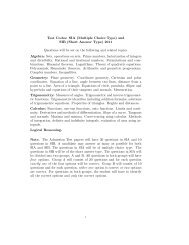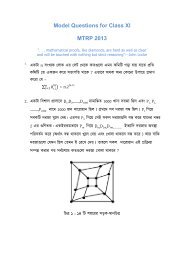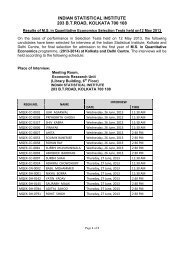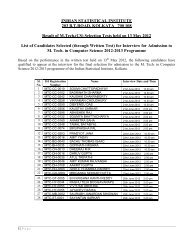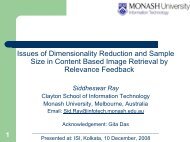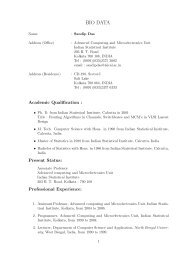A Simulated Annealing Based Multi-objective Optimization Algorithm ...
A Simulated Annealing Based Multi-objective Optimization Algorithm ...
A Simulated Annealing Based Multi-objective Optimization Algorithm ...
Create successful ePaper yourself
Turn your PDF publications into a flip-book with our unique Google optimized e-Paper software.
2exploration along the front. However, a proper choice of thew i s remains challenging task.In addition to the earlier aggregating approaches of multi<strong>objective</strong>SA, there have been a few techniques that incorporatethe concept of Pareto-dominance. Some such methodsare proposed in [16], [17] which use Pareto-domination basedacceptance criterion in multi-<strong>objective</strong> SA. A good reviewof several multi-<strong>objective</strong> simulated annealing algorithms andtheir comparative performance analysis can be found in [18].Since the technique in [17] has been used in this article forthe purpose of comparison, it is described in detail later.In Pareto-domination-based multi-<strong>objective</strong> SAs developedso far, the acceptance criterion between the current and a newsolution has been formulated in terms of the difference in thenumber of solutions that they dominate [16], [17]. The amountby which this domination takes place is not taken into consideration.In this article, a new multi-<strong>objective</strong> SA is proposed,hereafter referred to as AMOSA (Archived <strong>Multi</strong>-<strong>objective</strong><strong>Simulated</strong> <strong>Annealing</strong>), which incorporates a novel concept ofamount of dominance in order to determine the acceptanceof a new solution. The PO solutions are stored in an archive.A complexity analysis of the proposed AMOSA is provided.The performance of the newly proposed AMOSA is comparedto two other well-known MOEA’s, namely NSGA-II [19] andPAES [20] for several function optimization problems whenbinary encoding is used. The comparison is made in termsof several performance measures, namely Convergence [19],Purity [21], [22], Spacing [23] and MinimalSpacing [21].Another measure called displacement [8], [24], that reflectsboth the proximity to and the coverage of the true PO front,is also used here for the purpose of comparison. This measureis especially useful for discontinuous fronts where we canestimate if the solution set is able to approximate all the subfronts.Many existing measures are unable to achieve this.It may be noted that the multi-<strong>objective</strong> SA methods developedin [16], [17] are on lines similar to ours. The concept ofarchive or a set of potentially PO solutions is also utilized in[16], [17] for storing the non-dominated solutions. Instead ofscalarizing the multiple <strong>objective</strong>s, a domination based energyfunction is defined. However there are notable differences.Firstly, while the number of solutions that dominate the newsolution x determines the acceptance probability of x in theearlier attempts, in the present article this is based on theamount of domination of x with respect to the solutions inthe archive and the current solution. In contrast to the worksin [16], [17] where a single form of acceptance probabilityis considered, the present article deals with different forms ofacceptance probabilities depending on the domination status,the choice of which are explained intuitively later on.In [17] an unconstrained archive is maintained. Note thattheoretically, the number of Pareto-optimal solutions can beinfinite. Since the ultimate purpose of an MOO algorithm isto provide the user with a set of solutions to choose from, it isnecessary to limit the size of this set for it to be usable by theuser. Though maintaining unconstrained archives as in [17] isnovel and interesting, it is still necessary to finally reduce itto a manageable set. Limiting the size of the population (asin NSGA-II) or the Archive (as in AMOSA) is an approachin this direction. Clustering appears to be a natural choice forreducing the loss of diversity, and this is incorporated in theproposed AMOSA. Clustering has also been used earlier in[25].For comparing the performance of real-coded AMOSAwith that of the multi-<strong>objective</strong> SA (MOSA) [17], six three<strong>objective</strong> test problems, namely, DTLZ1-DTLZ6 are used.Results demonstrate that the performance of AMOSA iscomparable to, often better than, that of MOSA in terms ofPurity, Convergence and Minimal Spacing. Comparison is alsomade with real-coded NSGA-II for the above mentioned sixproblems, as well as for some 4, 5, 10 and 15 <strong>objective</strong> testproblems. Results show that the performance of AMOSA issuperior to that of NSGA-II specially for the test problemswith many <strong>objective</strong> functions. This is an interesting and themost desirable feature of AMOSA since Pareto ranking-basedMOEAs, such as NSGA-II [19] do not work well on many<strong>objective</strong>optimization problems as pointed out in some recentstudies [26], [27].II. MULTI-OBJECTIVE ALGORITHMSThe multi-<strong>objective</strong> optimization can be formally statedas follows [1]. Find the vectors x ∗ = [x ∗ 1, x ∗ 2, . . . , x ∗ n] T ofdecision variables that simultaneously optimize the M <strong>objective</strong>values {f 1 (x), f 2 (x), . . . , f M (x)}, while satisfying theconstraints, if any.An important concept of multi-<strong>objective</strong> optimization is thatof domination. In the context of a maximization problem, a solutionx i is said to dominate x j if ∀k ∈ 1, 2, . . . , M, f k (x i ) ≥f k (x j ) and ∃k ∈ 1, 2, . . . , M, such that f k (x i ) > f k (x j ).Among a set of solutions P , the nondominated set of solutionsP ′are those that are not dominated by any member of theset P . The non-dominated set of the entire search space S isthe globally Pareto-optimal set. In general, a multi-<strong>objective</strong>optimization algorithm usually admits a set of solutions thatare not dominated by any solution encountered by it.A. Recent MOEA algorithmsDuring 1993-2003, a number of different evolutionary algorithmswere suggested to solve multi-<strong>objective</strong> optimizationproblems. Among these, two well-known ones namely, PAES[20] and NSGA-II [19], are used in this article for the purposeof comparison. These are described in brief.Knowles and Corne [20] suggested a simple MOEA usinga single parent, single child evolutionary algorithm, similar to(1+1) evolutionary strategy. Instead of using real parameters,binary strings and bit-wise mutation are used in this algorithmto create the offspring. After creating the child and evaluatingits <strong>objective</strong>s, it is compared with respect to the parent. If thechild dominates the parent, then the child is accepted as thenext parent and the iteration continues. On the other hand ifparent dominates the child, the child is discarded and a newmutated solution (a new solution) is generated from the parent.However if the parent and the child are nondominating to eachother, then the choice between the child and the parent isresolved by comparing them with an archive of best solutionsfound so far. The child is compared with all members of the



